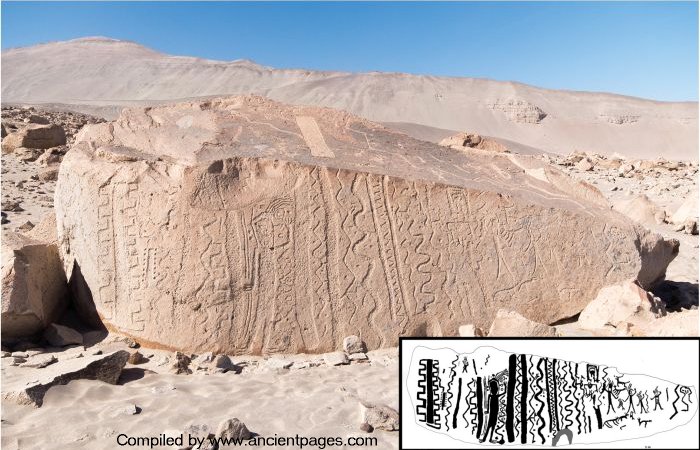Conny Waters - AncientPages.com - Peru is famous for being one of South America's most significant rock art sites. The fascinating Toro Muerto, a desert gorge, is situated amid hills from the east and west, descending into the Majes River valley. Its central area, spanning approximately 10 square kilometers, is dotted with thousands of volcanic boulders, of which around 2,600 have preserved rock carvings, known as petroglyphs.
Boulder TM 1219. Credit: A. Rozwadowski, source: Cambridge Archaeological Journal.
These petroglyphs range from small stones adorned with single motifs to massive boulders weighing several tons, their surfaces adorned with dozens of various depictions. The petroglyphs were created at different times, with the earliest ones likely crafted by members of the local Siguas culture approximately 2,000 years ago. In contrast, the Incas may have created the latest ones in the 15th century.
Toro Muerto's Petroglyphs Of The Dancers Are Unique
The petroglyphs of Toro Muerto have long been debated regarding their purpose and meaning. These rock carvings primarily depict zoomorphic motifs, such as figures of snakes and wild cats, and geometric patterns like vertical zigzags and straight and wavy lines of varying widths, sometimes accompanied by dots or circles.
Unique to the Toro Muerto petroglyphs are the drawings of the so-called "danzantes" or dancers. A danzante is a schematic drawing of a human figure, usually 20-30 cm high, often depicted in a dynamic pose with one arm raised and the other lowered, legs slightly apart (sometimes bent at the knees), and the head presented in profile or facing forward. While the geometric patterns, lines, and zigzags accompanying the danzantes were initially thought to represent snakes or lightning bolts, Polish scientists who analyzed these 2,000-year-old rock carvings have proposed a different theory.
The interpretation of the images found at the Toro Muerto archaeological site in Peru has been primarily based on analogies with other sites containing petroglyphs. Initially, it was suggested that the signs might symbolize snakes, lightning bolts, or elements related to the desert environment, such as heavy rains, water worship, or crops, but scientists now have a different theory.
Furthermore, the geometric patterns appearing independently were associated with representations of valleys, rivers, irrigation canals, roads, or trade routes, while the accompanying dots or circles were linked to stone mounds placed along communication routes.
Scientists have known about the site since the 1950s. Still, there has been no consensus among researchers regarding interpreting the function and meaning of the geometric signs accompanying the 'dancers' depicted in the Toro Muerto petroglyphs.
However, recent Polish-Peruvian research conducted at the site since 2015 has shed new light on this issue. The research involved detailed geodetic and iconographic documentation of the entire site and the first excavations at some of the boulders, providing fresh insights into the potential significance of these ancient carvings.
Many Of The Petroglyphs Represent Songs - Scientists Say
The research conducted by professors Andrzej Rozwadowski from the Adam Mickiewicz University in Poznan and Janusz Woloszyn from the University of Warsaw has led to a novel hypothesis regarding the geometric patterns accompanying the dancers depicted in the Toro Muerto petroglyphs. Their proposal suggests that these patterns may have represented songs, with the more intricate compositions serving as graphic metaphors for the transition to another realm. This interpretation offers an insightful perspective on the symbolic significance of the Toro Muerto petroglyphs, shedding light on the potential connection between the geometric designs and the rituals or beliefs associated with the depicted dancers.
Boulder TM 1219 in a wider landscape perspective. Credit: A. Rozwadowski, source: Cambridge Archaeological Journal.
"The source of our interpretive proposal is an ethnographic analogy from the Amazon, and more precisely, the art of the Tukano people living on the border of Colombia and Brazil,
Researchers noticed the similarity of its motifs to motifs from other parts of the world. Even Palaeolithic art from caves dating back several thousand years was interpreted on this basis
I began to analyze descriptions of Tukano art again and found that the Indians explained some of these motifs as representations of songs. Considering the accumulation of danzantes motifs in this place, one may ask: what do people dance to? They dance to songs. Once I started putting it all together, it started to fit.
It seems that no one had noticed it before, and this interpretative proposal basically suggested itself," Professor Rozwadowski told Science in Poland.
The comparative analysis of images from Toro Muerto and Tukano reveals recurring sequences and motifs. One of the most significant motifs can be described as a battlement, resembling the top of a defensive castle wall with a series of toothed, rectangular projections and openings.
"This content seems to fit our illustrations very well. Especially those visible on the TM 1219 boulder, which became the key, the gateway to interpretation. There is no other rock in Toro Muerto in which a human figure surrounded by geometric motifs is so well incorporated," says Professor Rozwadowski.
See also: More Archaeology News
"The dancer-zigzag combination appears on hundreds of stones, but only in this case is it such a complex sequence. This boulder is located in such a place that it is impossible not to notice it, and in front of it there is a large space where people could gather and listen to stories or songs," adds Professor Janusz Wołoszyn.
"The analogy we used leads to the conclusion that the meanings accompanying the images could be fluid and not unambiguous. At one moment, an image could carry a range of meanings. We assume that the motif did not necessarily have to mean what we associate it with most easily, and the cultural context is important," Rozwadowski says.
The study was published in the Cambridge Archaeological Journal
Written by Conny Waters - AncientPages.com Staff Writer
